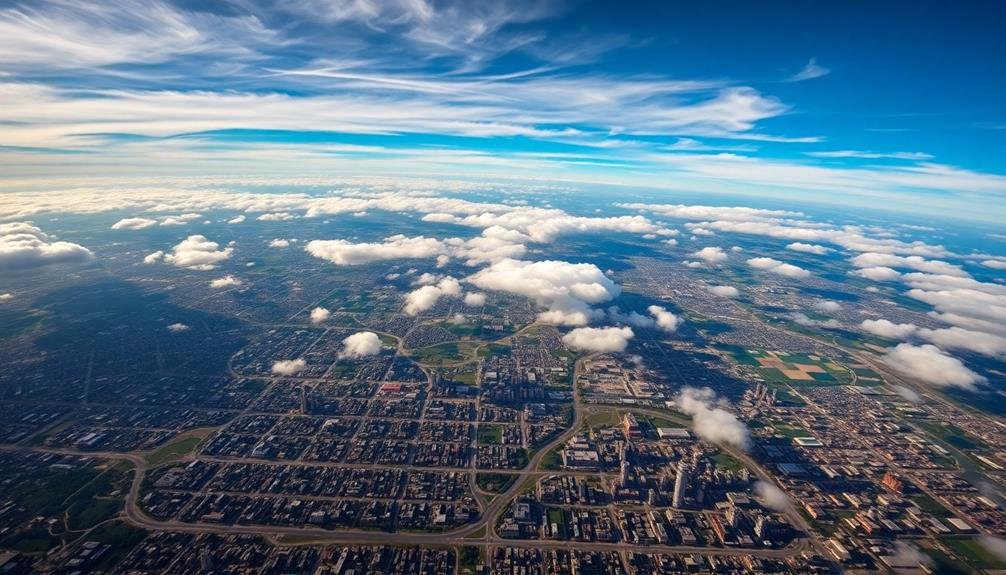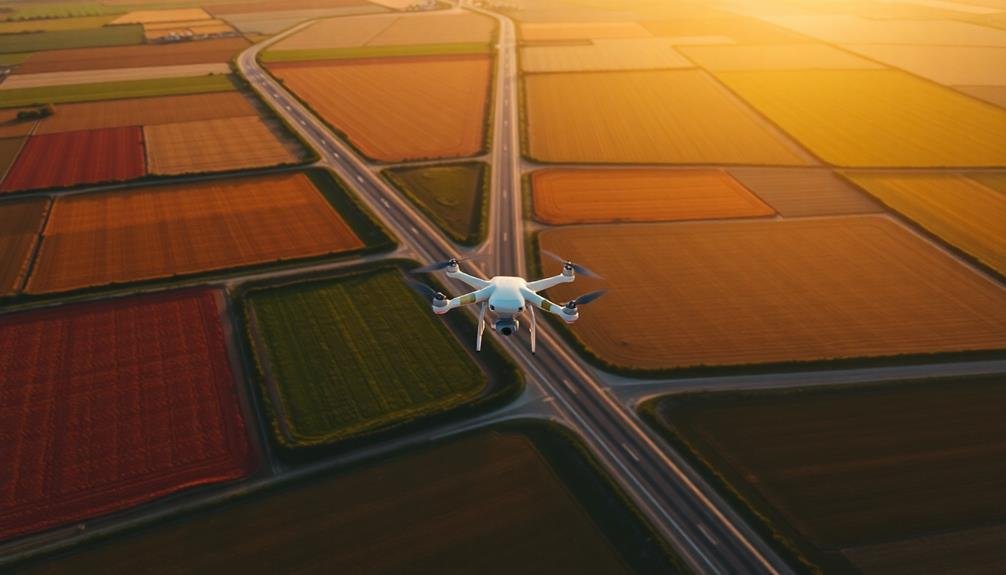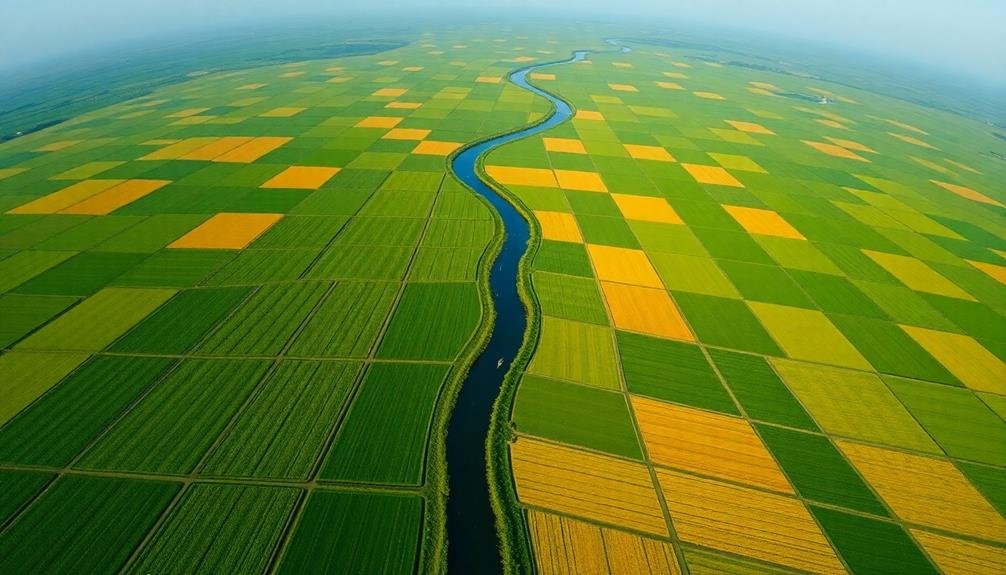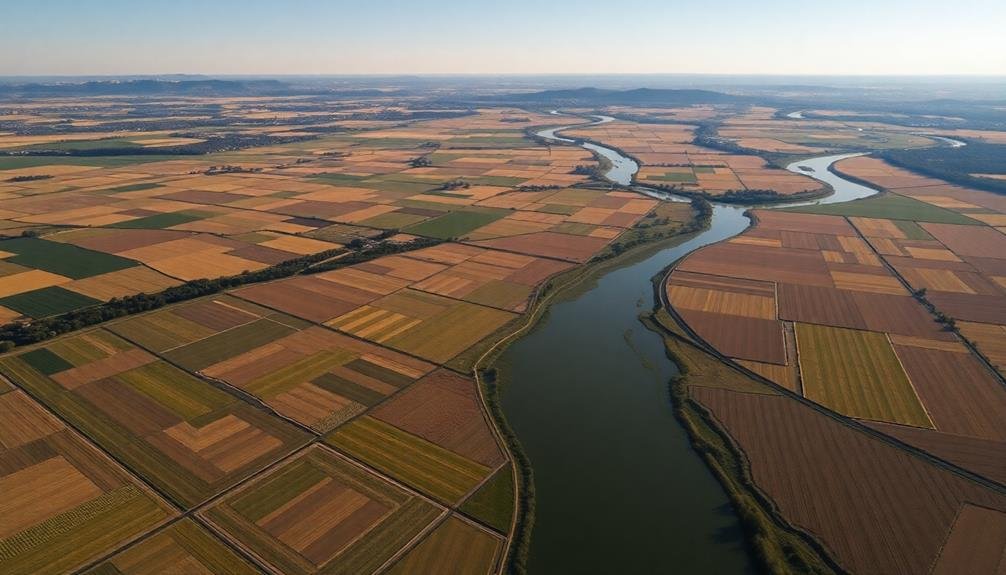When capturing patterns from above, you'll want to master these three key aerial techniques. First, use high-altitude perspective to reveal expansive views that showcase intricate designs invisible from the ground. Second, employ grid-based composition by dividing your frame into thirds, aligning key elements along these lines for a balanced shot. Finally, focus on symmetry and repetition, emphasizing uniform elements to create visually striking images. Remember to adjust your altitude and angle to optimize your compositions, and consider weather conditions for the best lighting. By honing these techniques, you'll unveil a world of mesmerizing aerial patterns waiting to be discovered.
Key Takeaways
- Utilize grid-based composition to align patterns with the rule of thirds for balanced and striking visuals.
- Shoot during golden hours for enhanced shadows and textures that emphasize patterns below.
- Adjust altitude and angle to optimize the scale and perspective of repetitive elements in the landscape.
- Employ high-resolution cameras with fast shutter speeds to capture crisp details of intricate patterns.
- Experiment with symmetry and near-symmetry techniques to showcase natural or man-made recurring structures.
High-Altitude Perspective

Soaring high above the landscape, aerial photographers reveal a world of mesmerizing patterns invisible from the ground. When you're shooting from high altitudes, you'll capture expansive views that showcase nature's intricate designs and human-made structures in ways you can't achieve at lower elevations.
To master high-altitude photography, you'll need to take into account several factors. First, choose the right aircraft. Helicopters offer more maneuverability and the ability to hover, while fixed-wing planes provide greater stability and range.
You'll also want to use a high-resolution camera with a fast shutter speed to combat vibrations and movement. Weather conditions play a vital role in your shots. Clear days offer the best visibility, but overcast skies can create interesting diffused light effects.
Time of day matters too; early morning or late afternoon light can enhance shadows and textures, making patterns more distinct. When framing your shots, look for repetitive elements, geometric shapes, and color contrasts.
Crop out distracting elements to emphasize the pattern. You'll find that zooming in on specific areas can reveal unexpected compositions, while wider angles showcase the grand scale of landscapes.
Grid-Based Composition

Drawing upon the principles of design, grid-based composition provides a powerful framework for organizing aerial photographs. When you're capturing patterns from above, imagine overlaying a grid on your viewfinder or camera screen. This mental grid helps you align elements within your frame, creating balance and structure in your images.
To effectively use grid-based composition in aerial photography:
- Divide your frame into thirds both horizontally and vertically.
- Place key elements along these lines or at their intersections.
- Use the grid to create symmetry or intentional asymmetry.
As you frame your shot, pay attention to how patterns and textures interact with your grid. You'll often find that natural or man-made patterns below align perfectly with grid lines, creating visually striking compositions.
Don't be afraid to adjust your altitude or angle to better fit elements within your grid structure.
Symmetry and Repetition Framing

Symmetry and repetition are powerful tools in aerial photography that can transform ordinary scenes into fascinating compositions. When shooting from above, you'll often encounter natural and man-made patterns that lend themselves to symmetrical framing. Look for buildings, roads, or landscapes with mirror-like qualities and position your drone to capture perfect balance.
To emphasize repetition, seek out uniform elements like rows of crops, parked cars, or beach umbrellas. Frame your shot to showcase the recurring shapes, colors, or textures. You can create a sense of infinity by filling the entire frame with repeating patterns, or use negative space to highlight the repetition against a contrasting background.
Don't limit yourself to perfect symmetry; near-symmetry can be equally compelling. Experiment with slight offsets or introduce a single contrasting element to add intrigue.
When framing repetitive patterns, try varying your altitude to change the scale and perspective. Remember, the key is to create visual harmony while maintaining interest. Use leading lines within the patterns to guide the viewer's eye, and consider how light and shadows interact with the repeating elements to add depth to your composition.
Frequently Asked Questions
What Camera Settings Are Best for Aerial Photography?
For aerial photography, you'll want to use a fast shutter speed (1/1000s or higher), a medium aperture (f/5.6-f/8), and low ISO. Set your camera to continuous shooting mode and use autofocus for sharp, well-exposed images.
How Do Weather Conditions Affect Aerial Pattern Photography?
Weather greatly impacts your aerial pattern shots. You'll find bright, clear days enhance contrast and colors. Overcast conditions soften shadows, while wind can blur patterns. Avoid rain and fog, as they'll obscure details you're trying to capture.
Are There Any Legal Restrictions for Drone Photography in Urban Areas?
You'll face legal restrictions for drone photography in urban areas. You're often required to obtain permits, follow altitude limits, and avoid no-fly zones. Don't forget privacy laws and property rights when capturing images from above.
What Post-Processing Techniques Enhance Aerial Pattern Photographs?
You'll want to enhance contrast and saturation to make patterns pop. Try adjusting levels, sharpening edges, and playing with perspective correction. Don't forget to experiment with cropping to highlight interesting geometric shapes in your aerial shots.
How Can I Stabilize My Camera for Sharp Aerial Shots?
You'll want to use a gimbal or stabilizer to keep your camera steady. Mount it securely, set a fast shutter speed, and enable image stabilization. Practice smooth movements and consider using a remote trigger for hands-off shots.
In Summary
You've now got the tools to capture stunning aerial patterns. Remember to experiment with high-altitude perspectives for unique views, use grid-based composition to organize your shots, and seek out symmetry and repetition in your framing. Don't be afraid to push your creativity and try new angles. With practice, you'll develop an eye for spotting intriguing patterns from above. So grab your drone or book that helicopter ride – the sky's the limit for your aerial photography!

As educators and advocates for responsible drone use, we’re committed to sharing our knowledge and expertise with aspiring aerial photographers.




Leave a Reply